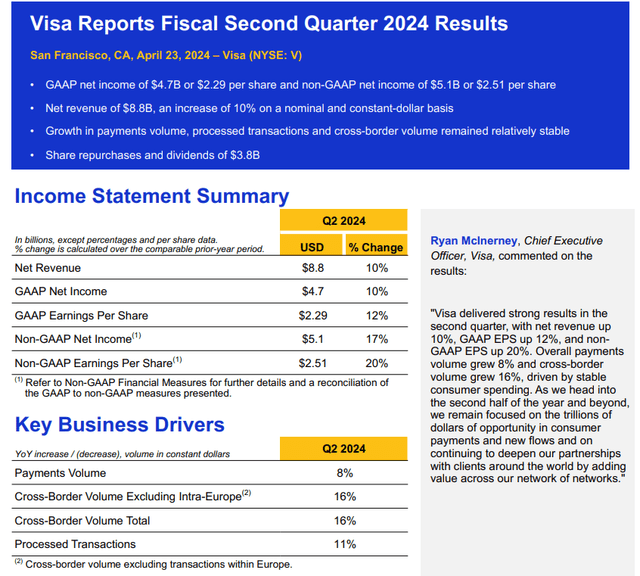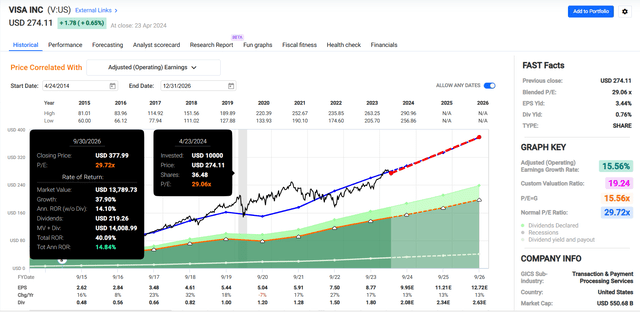Summary:
- In my view, Visa has undisputedly proven itself as one of the most incredible dividend growers in the dividend stock universe.
- The juggernaut payment processor’s net revenue and adjusted diluted EPS jumped during the fiscal second quarter.
- Visa’s AA- credit rating from S&P is one of the most admirable in the world.
- Shares of the company could be trading at an 11% discount to fair value.
- Visa offers a one-two punch of growth/dividend growth and value, which could lead to strong future total returns.

A young man shops online with his payment card ready.
MStudioImages
In my life, I have several interests. I enjoy spending time with my immediate family. I also like to casually watch TV series (my nine-year-old nephew and I are currently finishing up the medical drama House). Thirdly, I enjoy jogging/running five days a week and weightlifting four days a week.
When I’m not doing those things, though, chances are I’m probably researching/keeping up with mostly dividend growth stocks. For me, stumbling across and investing in high-quality dividend growth stocks is a pleasurable activity.
After almost seven years of real-money investing, five-plus years of writing for Seeking Alpha, and nearly three years of writing for a living, some stand out above the rest.
Visa (NYSE:V) is one dividend growth stock in my portfolio that seemingly never ceases to amaze me. As I’ll get into later, the company consistently tops analyst estimates, has an AA- credit rating from S&P, and boasts mindboggling profit margins. The pre-existing business-to-consumer payments opportunity that has played out for many years now and emerging government payments growth opportunity each figure to be notable growth catalysts.
The payment processor’s weighting within my 100-stock portfolio is 1.6%, which is enough to make it my 16th-biggest holding.
When I last covered the company in January with a buy rating, I liked Visa for its immense profitability, safe and growing dividend, and valuation.
Today, I’ll be revisiting Visa’s fundamentals and valuation to outline why I’m still holding it as one of my portfolio’s bigger positions. Succinctly, the fiscal second-quarter earnings results from yesterday (April 23) were robust, the future outlook remains promising, and shares still offer a mix of growth and value.
Visa’s Momentum Is Self-Sustaining

Visa Q2 2024 Earnings Press Release
Among the many things that I appreciate about Visa, the company’s consistency has to be one of my favorite characteristics. Heading into the fiscal second quarter results, Visa beat the net revenue analyst consensus in the last 14 quarters according to Seeking Alpha. Separately, the company surpassed the analyst consensus for adjusted diluted EPS in each of the last 16 quarters leading up to Q2.
Visa didn’t let me down in the fiscal second quarter, either. The company’s net revenue climbed 9.9% year-over-year to $8.8 billion for the quarter. This was $180 million better than the analyst consensus.
What was behind this impressive growth? As has been the case in previous quarters, Visa’s key performance indicators were positive across the board.
The company’s total card count heading into the fiscal second quarter was over 4.4 billion. For context, this was 4.9% greater than the 4.2 billion cards in circulation at the start of the year-ago period.
Growth in Visa’s card count can largely be attributed to the massive collective purchasing power of this card base. Merchants may not be keen to absorb swipe fees, but they simply can’t afford to turn away billions of potential customers by not accepting Visa’s payment network.
Coupled with stable consumer spending, this is what propelled payment volume higher by 8% during the fiscal second quarter.
These elements also propelled total processed transactions higher by 11% year-over-year for the fiscal second quarter.
Consumers also remained eager to travel abroad in the fiscal second quarter. Because many international travel plans were delayed due to the COVID-19 pandemic, this makes sense. After two years of restricted travel, consumers are making up for lost time with travel as of late.
Visa’s adjusted diluted EPS surged 20.1% higher over the year-ago period to $2.51 during the fiscal second quarter. This was $0.08 ahead of the analyst consensus per Seeking Alpha. As I have noted in past articles, the company’s scalability is another trait that makes it a great business.
Visa’s non-GAAP operating expenses only grew by 11.3% to $2.6 billion for the quarter. Since net revenue growth outpaced non-GAAP operating expenses growth, the company’s non-GAAP net profit margin improved by 340 basis points to a blistering 58.3% in the quarter. Out of the companies I routinely cover, these are the highest profit margins by a lot.
Aside from Visa’s steadily growing business-to-consumer avenue, the company has yet another promising growth path: Government payments. This market alone represents a $15 trillion-plus annual opportunity for the payments processor per CFO Ryan McInerney’s opening remarks during the Q2 2024 Earnings Call. Seizing on this opportunity alone would provide a substantial boost to Visa’s payment volume base of $15 trillion and counting.
Leveraging its brand recognition, the company recently signed an agreement in Kenya with Pesaflow. This will bring Visa Direct onto the Kenyan government’s eCitizen platform. There will probably be more deals to follow, which will further bolster Visa’s total payment volume. Thus, I think Visa’s reputation of beating the analyst consensus should continue.
It’s also important to note that even if the company simply matches the analyst consensus, growth would be impressive enough. This is because thanks to the tailwinds that I noted, the FAST Graphs analyst consensus is for 13% compound annual adjusted diluted EPS growth for fiscal years 2024 through 2026.
As Visa further grows out its cards in circulation, the number of merchants worldwide that accept its payment network should keep growing. Coupled with the measured push into government payments, I would be surprised if Visa didn’t even slightly outperform the FAST Graphs analyst consensus.
Moving forward, I will be monitoring the company’s progress in government payments, as well as the key performance indicators that I outlined earlier.
If these growth prospects weren’t enough, Visa also has an exceptional balance sheet. The company’s net debt (cash and cash equivalents plus investment securities minus long-term debt) was $2.9 billion to end the fiscal second quarter. Because of Visa’s AA- credit rating from S&P, the company’s long-term debt was mostly locked in at low-interest rates. That is how investment income was $159 million during the quarter (unless otherwise hyperlinked or noted, all info in this subhead was sourced from Visa’s Q2 2024 Operational Data PDF, Visa’s Q2 2024 Earnings Press Release, and Visa’s Q2 2023 Operational Data PDF).
Simply put, these vigorous fundamentals are what make Visa an all-weather investment in my view.
The Valuation Is Still Interesting
In the last three months, shares of Visa have been relatively flat as the S&P 500 (SP500) has edged 3% higher. I believe this range bound movement in the share price could mean shares remain attractively valued.
For one, Visa’s five-year average dividend yield of 0.64% points to a fair value of $325 per share. Visa’s dividend will indeed make up a minority of its total returns for the foreseeable future. However, as the company keeps growing, I expect the payout ratio to gradually expand.
That’s because as growth opportunities lessen, the emphasis on shareholder returns will increasingly be dividends (on top of share repurchases that are already in progress). This means that while Visa is more of a growth play right now, it is ripe for the picking as a dividend grower. Given that Visa’s teens annual growth rate is intact, I believe that a reversion to right around that 0.64% yield will eventually be in order.

FAST Graphs, FactSet
My other fair value method is the current-year P/E ratio. The FAST Graphs adjusted diluted EPS analyst consensus for fiscal year 2024 is $9.95. In light of Visa’s growth catalysts that I highlighted, I believe this earnings input is sensible.
Pairing that up with a 10-year normal P/E ratio of 29.7, this yields a $296 fair value. Since the growth story remains fine from my view, an eventual reversion to this valuation multiple is arguably likely.
Averaging out these fair values, I get a fair value of $311 apiece. Compared to the $276 share price (as of April 24, 2024), this equates to an 11% discount to fair value.
Relative to my previous article, my fair value in the $310s remains unchanged. However, I believe yet another quarter of better-than-expected results provides even more support for this fair value.
A Dividend Aristocrat In The Making
Since initiating its quarterly dividend per share in 2008, Visa’s payout has soared nearly 20-fold to the current rate of $0.52. Of all the businesses I cover, I am not aware of any with similar dividend growth in a decade and a half period. The most recent 15.6% dividend raise announced last fall also suggests that dividend growth remains strong.
If the company can pay its current rate throughout this year, it will have upped its dividend for 16 consecutive years. That puts Visa on pace to become a Dividend Aristocrat in the first half of the next decade.

Dividend Kings Zen Research Terminal
Judging by the company’s 21% EPS payout ratio, I think it will have no problem becoming a Dividend Aristocrat. That’s because this payout ratio clocks in well below the 60% EPS payout ratio that rating agencies want to see from the industry.
Visa’s free cash flow payout ratio was almost as impressive. The company generated $7.6 billion in free cash flow through the first half of fiscal year 2024. Against the $2.1 billion in dividends paid in that time, that works out to a 27.9% free cash flow payout ratio (per Visa’s Q2 2024 Earnings Press Release).
Visa’s reputation as a dividend grower and low payout ratios earn it an A+ grade from Seeking Alpha’s Quant System for dividend safety. The 16.1% compound annual growth rate of the dividend in the past five years is also enough for an A grade for the 5Y dividend growth rate.
These factors arguably make up for Visa’s approximately 0.8% forward yield being far below the financial sector’s median of 3.6%. For me, that compensates for the F grade for forward dividend yield in Seeking Alpha’s Quant System.
Risks To Consider
For my money, Visa is one of the best businesses in not just my coverage universe but overall. That doesn’t mean it is free from risks, though.
Per Seeking Alpha, Visa and Mastercard (MA) agreed to keep lower interchange rates into 2030 late last month. This was done to assuage the concerns of small business owners. From what I can tell, it seems like this will go a long way in doing so. But if it doesn’t, additional pressure from business owners and lawmakers could ensue. That could pressure the industry’s sizable profit margins.
Just as I discussed in my prior article, Visa must maintain its brand image to keep delivering success to shareholders. If anything like major litigation or a cyber breach were to derail the company’s reputation, growth potential could be damaged.
Summary: Growth At A Reasonable Price In Plain Sight
By every measure, Visa is a superb business. The company is printing profits at levels, of which most of Wall Street can only dream. Thanks to meaningful tailwinds, these profits are also consistently growing year in and year out (since going public, Visa’s adjusted diluted EPS only declined in FY 2020 per FAST Graphs). For its profitability, the company’s balance sheet is a bonafide fortress.
Yet, Visa stock can be acquired for a high-20s current-year earnings multiple. For a business routinely growing by double-digits, that’s why I think Visa is an obvious pick for growth at a reasonable price.
Analyst’s Disclosure: I/we have a beneficial long position in the shares of V, MA either through stock ownership, options, or other derivatives. I wrote this article myself, and it expresses my own opinions. I am not receiving compensation for it (other than from Seeking Alpha). I have no business relationship with any company whose stock is mentioned in this article.
Seeking Alpha’s Disclosure: Past performance is no guarantee of future results. No recommendation or advice is being given as to whether any investment is suitable for a particular investor. Any views or opinions expressed above may not reflect those of Seeking Alpha as a whole. Seeking Alpha is not a licensed securities dealer, broker or US investment adviser or investment bank. Our analysts are third party authors that include both professional investors and individual investors who may not be licensed or certified by any institute or regulatory body.
